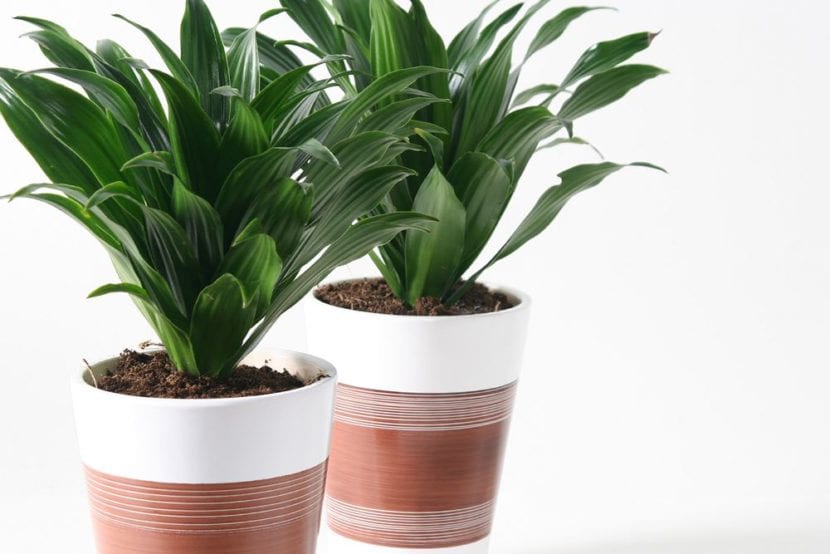
Image - Bunnik Plants
The plant that I am going to talk to you about next is one of those that look very, very good in any corner of the home. I insist: on anyone. And no, I'm not telling you that it has a slow growth rate, that it does, but that it is also a plant that stays small, measuring no more than two meters in adulthood. Your name? Dracaena fragrans »Compact», although it is much better known by the name of, simply, Compact dracaena.
It is very resistant, being one of the most suitable for beginners. It is also pretty and does not make a mess. Let's get to know it more in depth.
Main characteristics of the compact Dracaena
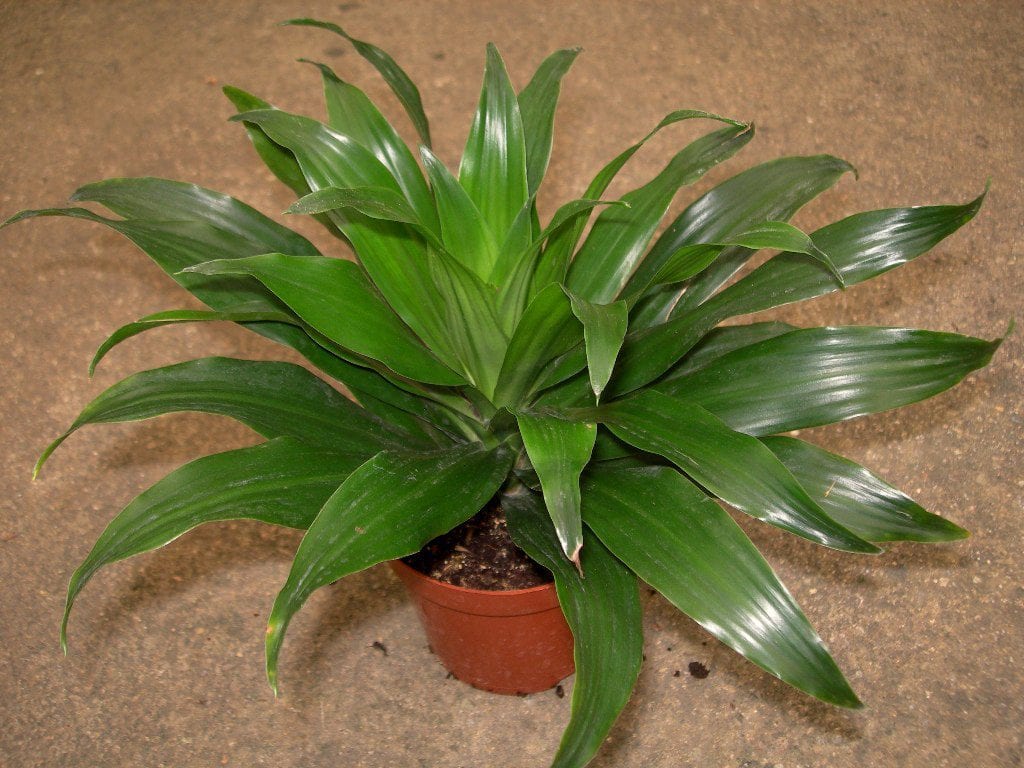
Image - Viveros Van Garden
This is a tropical shrub native to the African continent that belongs to the Asparagaceae family. It has a very thin trunk, barely 5cm wide, and a maximum height of 1m. Its leaves are short, up to 40cm long, pointed to a point, and bright green that will combine wonderfully with the decoration of the room where you want to put it.
The flowers are white and give off a very intense aroma, pleasant. In fact, that's where the name fragrans comes from. These are pollinated by many insects and even hummingbirds. Although, unfortunately, when they are grown in a pot and being so slow growing, it can take many years for us to contemplate their flowers.
Care
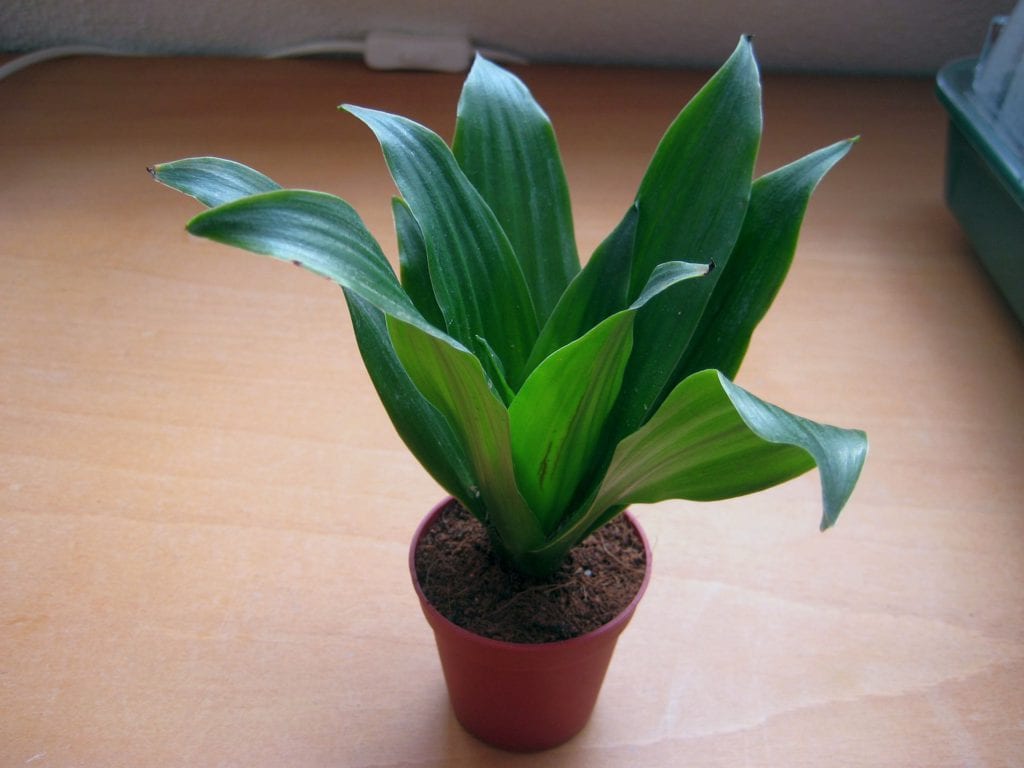
Image - Green 24
The compact Dracaena is not demanding at all. Even so, you have to take into account a series of things so that it grows healthy and without problems for many years, and they are:
Location
Ideally place it in a room with plenty of natural light, although it may be a little dark in others. It can be kept outside protected from direct sun as long as the temperature does not drop below 5ºC.
Irrigation
It resists drought better than overwatering, so it is important to let the substrate dry before watering again. As usual, it is recommended to water once or twice a week, once or twice more if you are abroad.
Subscriber
We cannot forget the subscriber. From spring to late summer (we can also in autumn if the weather is mild, without frost) It is advisable to fertilize with a universal fertilizer for plants or with liquid organic fertilizers, such as guano, humus, or algae extract. You can even pay one month with one, and the next with another, so that in this way we make sure that the plant gets all the nutrients it needs. Of course, you have to read the label, especially if we use mineral fertilizers.
Transplant
We have to transplant our compact Dracaena every two years, transferring it to a pot about 3-4cm wider than the previous one. The type of material with which the container is made is a very personal decision, but it is true that terracotta are very beautiful (see header image); although it must also be said that it is becoming easier to find plastic pots that have nothing to envy them.
Substratum
As a substrate, you must use one that is porous, in order to prevent it from remaining wet for too long, and that could also provide it with a large amount of nutrients. So, a good mix would be for example: 40% black peat + 40% perlite + 20% worm castings, which contains nitrogen, phosphate, potassium, and micronutrients, such as zinc or manganese, all of them very necessary for a correct growth and development of the plant.
Dracaena compact problems
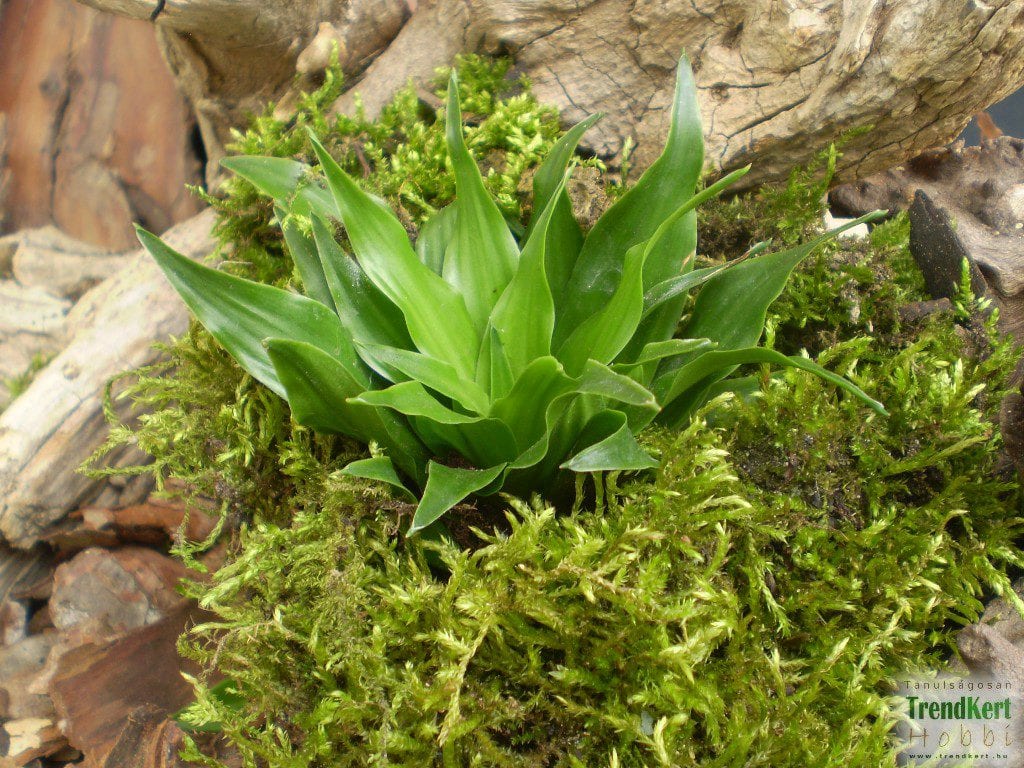
Image - Trendkert
Although it is very resistant, it can also have some problems:
Soft trunk
If you have or begin to have a soft trunk, it is a sign that we've been going overboard with the irrigation. In this case, you have to suspend it and let the soil dry completely before watering again. And, in addition, you have to do a fungicide treatment.
Leaves that seem to fall
When the leaves are a little lower than they should be, chances are that be in a room where there is not enough light, so it will have to be moved to another area that is better lit.
Leaves with brown spots
Brown spots are a symptom of fungi, specifically of the genus Fusarium. This microorganism attacks when the climate is warm, and the substrate is humid. Therefore, the risks must be spaced and, to avoid the attack lasting more than necessary, make a treatment with a fungicide that contains Benzimidazole.
White / red spots on undersides of leaves
If you see that it has white or red dots on the leaves, it could be that they are mealybugs. To check this, just try to remove them with a cotton swab from your ears. If they go away easily, it will be these insects. As it is a small plant, they can continue to be removed with the sticks, although it is worth doing a treatment with paraffin oil.
Reproduction of Dracaena compacta
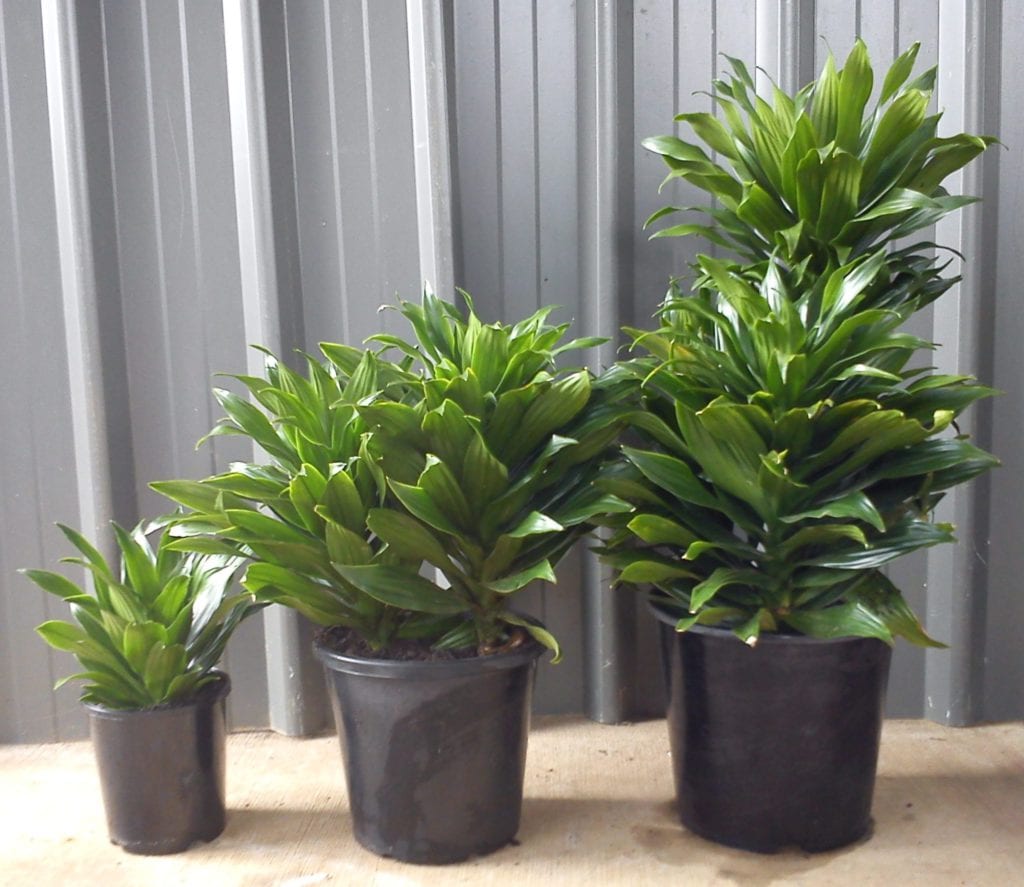
Image - Loutos Yasmeen Flowers
This plant reproduces by terminal stem cuttings, that is, the crown of leaves is cut from each branch, leaving it with a 10cm long stem. Then it continues as follows:
- The first thing to do now is remove the leaves of the cutting.
- Afterwards, the base is moistened (about 10cm) with water and is infused with rooting hormones powdered.
- Then a pot is filled with a very porous substrate, like black peat mixed with perlite in equal parts.
- Then, the cutting is planted, putting it right in the center.
- It waters generously.
- And finally, 2-4 wooden toothpicks are placed, and the pot is wrapped with plastic, as if it were a greenhouse. It is advisable to make some tiny holes to avoid that the humidity inside is high enough so that the fungi can reproduce and damage the cutting.
Now it only remains to keep the substrate always slightly damp, and wait. Cutting will start to root after about a month at a temperature of 24ºC.
What did you think of the compact Dracaena? Do you have any at home?
Hello Monica. I have had a compact dracena like the one in this article for 1 month. The man from the nursery transplanted it into a bigger pot and put a substrate (I don't know which one) taken from a closed bag and pieces of pine bark. I placed it in a place with some light and I have watered it very little, as indicated. He was fine until some very small and annoying mosquitoes began to flutter him, to walk him on the pine bark, and to flutter in the environment too. What can I do to eliminate them? From already thank you very much!
Hey.
These flies usually appear when overwatered. To eliminate them, you can use anti-flying insect adhesive strips that you will find in nurseries, or cover the substrate with decorative stones.
A greeting.
Hi there! I liked the article, I have some compact Dracaenas at home and I did not know their name. I will be putting into practice the advice for your care. Greetings.
I'm glad it's helpful to you, Yuli 🙂
Hello, I have two dracaenas and one of them grows tall but the other is growing very open and the tips and edges of the leaves are wrinkling. The two are located in the same place. They have little watering and very good color but I am concerned that each one grows in one way and that of the wrinkled leaves. Thanks a lot.
Hi Alicia.
The truth is that no plant is the same, not even if they are from the same batch of seeds or come from the same mother plant.
Have you checked if it has any plagues? Cottony mealybug for example. If you have nothing, you are probably short of compost. You can fertilize them with a specific fertilizer for cacti and other succulents (they are not cacti or succulents, but they have the same nutritional needs).
A greeting.
I have three and they don't grow, they were given to me without a pot and in water. I planted them, I bought land but they are still the same for almost three months.
Hi Gladys.
You have to be patient. These grow very slowly 🙂
Greetings.
Good morning, can you put organic fertilizer on the plant? If so, how often is it applied? Thanks a lot.
Hi pao.
Of course. If you have it in a pot of about 10,5cm in diameter you can put 1-2 tablespoons in it once a month. Although if you can get guano in liquid form, it will be better because being liquid does not hinder drainage.
A greeting.
Hello. My dracena has been doing very well until recently (10 months). Now brown spots are coming out in the middle of some leaves and also on some edge (like bites). What I can do ?
Hello Nemrac.
The first thing, I recommend you look at the leaves, looking for pests. If it has bites, perhaps a caterpillar or larva is doing its thing.
In the event that you cannot find anything, is the ground dry, or on the contrary, very humid? Brown spots are usually due to excess water. If it is in a pot without holes, or with a plate underneath, the roots will die. Therefore, you have to avoid that, both closed pots and putting a plate on it.
Greetings.
Hey there..
I have a compact ten and some leaves have dry pieces in the center of the leaves ... what can it be? Thanks a lot…
Hi Hope.
It can be several things:
- That the sun is giving him: it must be placed in semi-shade.
-What is being watered from above or spraying: he does not like it too much 🙂.
-Or that it has fungus: in which case it would be necessary to water less (once or twice a week is enough) and treat it with fungicide.
A greeting.
Hello,
I have a dracaena and the tallest trunk, the trunks that are born from the main trunk have turned black and soft. I have had to cut them. Which may be due? will it be reborn from the trunk?
Hello Beatriz.
It is probably due to overwatering. It is important to water by letting the soil dry between waterings.
A greeting.
Hello
I have had a compact fragrant dracena for thirty years, it is a very decorative plant, with low demands, and to my surprise, it bloomed a month ago. , You . You can not imagine the fragrance that it expels, it is really wonderful!
It is a very interesting plant because of how easy it is to care for and how beautiful it is.
Congratulations on that bloom. Without a doubt, he must be very comfortable.
Greetings.
Hello, good afternoon. we have some compact dracena pots recently, maybe a month ago and leaves started to fall from the springs. what will happen . Thank you.
Hello Heriberto.
There may be a problem with the watering, or with the pot. We recommend keeping it in semi-shade (protected from the sun), and in a container with holes in the base.
Irrigation should be moderate to little, since excess water hurts a lot.
Greetings.
I have had a compact dracaena for 7 years ... it was going very well but I accidentally watered it with vinegar (I reused a bottle and hence my big mistake by not marking it) I have watered it again with water but the substrate was still wet ... the leaves have been been putting black and not only those closest to the ground but throughout the plant. Will you have salvation? Would it help if I change the entire substrate? It saddens me very much to see her getting less and less leaves ...
Hi Claudia.
Ugh, yes, the best thing in that case is to remove the substrate, wash the roots with water, and then plant it in a pot with new soil.
And to wait. Under these conditions, it is the only thing that can be done.
Good luck!
I have two bushes, one of more than one meter I want to reproduce, I can cut it and make new plants or just take out the new ones and in what month
Hello Didima.
Yes, you can cut it if you want, in spring. Use a serrated knife and hand saw previously disinfected with pharmacy alcohol or dish soap.
Regards!
Hello,
I have had a compact dracaena for 10 years and the tips of the leaves are always black. I have read that little irrigation and fungicide with benzimidazole, but I can not find this one .... does any fungicide work?
Thank you
All the best
Hi miguel.
More than fungicide, I recommend planting it in a larger pot if it has been in it for more than 3 years, since it has probably run out of space.
If it still doesn't improve, then any systemic fungicide should help.
Regards!
Hi, thanks for all the information. I have a Compact Dracaena about 4 years ago that they gave me as a gift and the leaves dried at the tips, I was removing them and the trunk was bare, 50 cm or more, with only a few leaves on top. I thought they were going to come out again but no ... what can I do to get it back? It was always indoors and now on the terrace but the leaves have long since been lost. Thank you
Hi Vicky.
Have you ever changed the pot? If you have not, I recommend doing it as soon as possible, since surely you have run out of space to grow.
Regards!